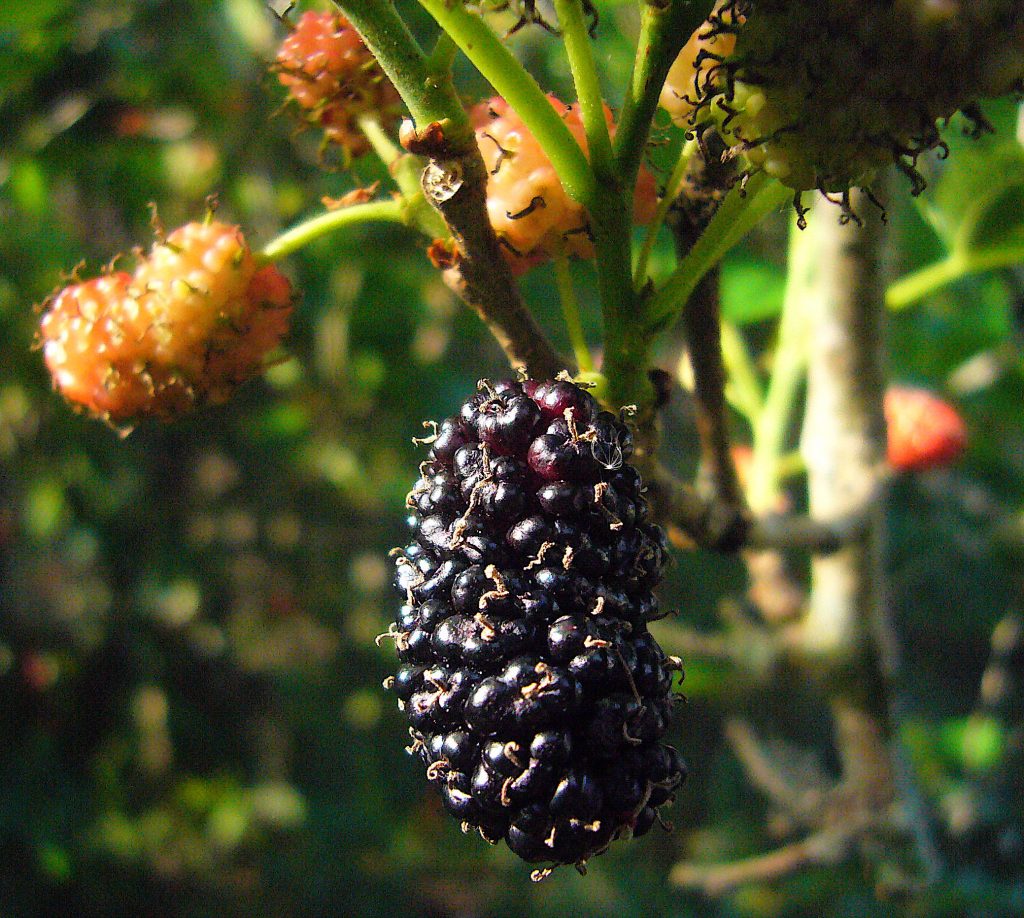
Mulberries resemble over-grown blackberries. Photo by Green Deane
There’s a fruiting mulberry near you. Locally the season is approaching. During a foraging class this past weekend we saw a huge red mulberry a couple of weeks shy of having gallons of ripe fruit. April is a target month for a lot of wild fruit locally including, red mulberries, blackberries, blueberries and the start of black cherries. While you can find mulberries nearly anywhere, they tend to favor past agricultural land, such as truck farms.
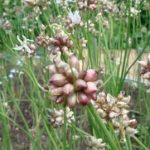
Wild Garlic will be cloving soon. Photo by Green Deane
Also seen was wild garlic, allium canadensis. It is in transition. The tasty allium comes up in January, puts blossoms and cloves on top in March and in April ripens into onions with easy-to-spot cloves. We dug up many in Sunday’s class. A true allium, they like sunny damp areas and spread by spring floods floating their cloves down stream. These are not “ramps” or “leeks” though related to those popular wild species. It has a small onion on the bottom and garlic cloves on top, and an edible stalk in between. Locally they are found throughout most of the state from Largo to Orlando to Gainesville.
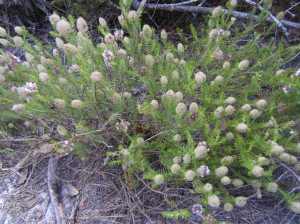
Florida Pennyroyal is also in blossom. Photo by Green Deane
If you are one to wander around sandy scrub in Florida this time of year you will see the low blooms of the Florida Pennyroyal. It’s quite an unusual plant in that it is monotypic, meaning it is the only plant in its genus. Found along the Central Florida Ridge though I have seen it also on the east coast of the state. There are a few plants in the Bahamas and maybe one or two in southern Georgia. It has the unmistakable aroma of pennyroyal. A species that looks vaguely similar, Florida Rosemary, has no noticeable strong aroma. Florida Pennyroyal used to be the third most common nectar plant in the state but fell off for some unknown reason and was replaced by Bidens alba, the Spanish Needles. Florida Pennyroyal was used extensively by the natives and has culinary uses. To read more about it go here.
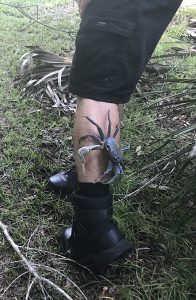
To a startled Land Blue Crab a leg is as good as a tree. Photo by Green Deane
Foraging classes, we’ll visit two opposing coastal area this weekend. Might even see a land crab or two at Princess Point, see photo right.
April 1st, Red Bug Slough 5200 S. Beneva Road, Sarasota, 9 a.m.
April 2nd Princess Place Preserve, 2500 Princess Place Road, Palm Coast, FL, 32137. Meet at middle Parking lot. 9 a.m.
For more information. to sign up for a class or to pre-pay go here.
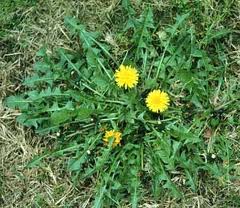
Dandelions like cooler weather. PHoto by Green Deane
There is perhaps no more commonly known wild weed than the Dandelion. Whether a child blowing aways the Dandelion puff or a seasoned pallet flavoring coffee with the roasted root, Dandelions are user friendly. My first batch of wine — after two five-gallon batches of beer — was Dandelion wine, made when I was in the 8th grade. It was very reasonable choice: I could not buy wine, I did not have a driver license, and Dandelions were everywhere. That was more than a half-a-century ago in Maine where summer Dandelions grew large and luscious. Now I live in Florida and Dandelions here are usually anemic winter stragglers. That first experience with a wild wine makes it easy to realize how wine-making evolved. There was no great preparation. I put blossoms, water, sugar and yeast into a 5-gallon crock, the top covered with a towel. When it was done working it went into old glass coca cola bottles. Perhaps it was beginners luck but it worked wonderfully. It doesn’t always, that’s for sure as subsequent failures over the years have proved. After some 50 years of wine making I am not cavalier about it but not super fastidious either. What you also learn is that most wine recipes are basically the same with minor variations. I will admit that of all my videos on You Tube the one on making a quick hard cider is the most watched. I’m probably corrupting some 8th grader out there… who might grow into a great wine maker. As I tell my classes, Damdelions like acidic soil and cold weather. Florida is a hot limestone plate. So we have to look for them in the winter in lawns near oaks and pines, which happens to be the area south of the dog park in Wickham Park. To learn more about Dandelions click
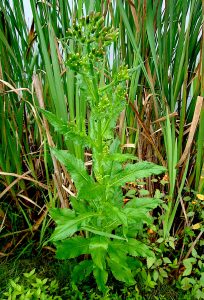
Burnweed/Fireweed in blossom in front of cattails. Photo by Green Deane
Fireweed/Burnweed has a flavor chefs love. With an impossible scientific name and strong aroma Fireweed is often over looked by the foraging community. Conversely the aroma is also a good identifying characteristic. As with several things in life tastes vary and many people enjoy the Fireweed raw or cooked. Closely related to the Dandelion, the Fireweed locally favors the late winter or early spring. Currently you can find Fireweed from a few inches high to a couple of feet. While they do not grow in colonies often several will grow near each other. Soon the older ones will put on yellow blossoms that barely open, another identifying characteristic. Of course in greens young and tender is usually preferable and this is particularly true with the Fireweed which grows rank as it ages. To read about fireweed go here.
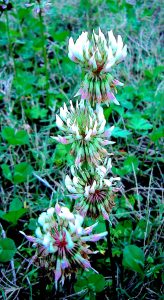
Clover prefers low nitrogen soil.
Clover is one of those wild edibles that is both overstated and understated. The overstatement is from writers who offer it as a great human food full of this and that to keep us healthy. The understated part is that it can harbor a fungus that inhibits clotting and somewhere around a half-a-cup of raw leaves can make you throw up. Individual experience, of course, can vary and there are several different species of clover with different characteristics. Pictured here is a nice little White Clover which is blossoming now mostly in lawns and athletic fields. A few leaves can be eaten raw. They are high in protein for a leaf. The blossom fresh or quickly dried can be used for tea. There is also Crimson, Red, Sweet and even Tick Clover.
Almost out of season now is stinging nettle (in the urtica family.) Also gone until next winter is real chickweed, it’s relative west Indian CHickweed, is still abundant. Cucumberweed will be around for a few more weeks in shade but is already aging in many locations.Also heading out of season is Goosegrass. Still in seasons are sow thistles and various mustards.
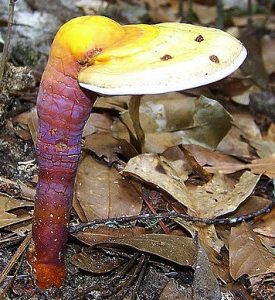
Ganoderma curtisii, a local reishi msuhroom. Photo by Green Deane
When will we be seeing and reading about mushrooms again? The answer is probably after spring rains in April or May or so. One can find various edible and medicinal mushrooms all year here but April to November is prime time for ground-based fungi (November to April for wood-based fungi.) I harvested several pounds of chanterelles last year. The topic of mushroom came up in the foraging class this week as we saw some “Train Wreckers” and Ganodermas starting their seasonal growth. Several species are called “Train Wreckers” because they can destroy railroad ties. None of them are toxic but some are too tough to digest and are related to Shiitake mushrooms. We also have several species of Ganodermas locally (Reishi) which is a bit of contention. The debate is how many species are there, what are they called, and are they as good as the ones that are sold for medicinal use? As for the latter my herbalist friends say yes, they are as good as the commercial kinds. As for how many and what they are called that probably won’t be settled for decades. I see three, or five, regularly, it’s hard to tell. With certainty I see G. curtisii, G. sessile, and G. zonatum. G. curtisii grows like a short golf club and is the closest relative to G. lingzhi, which is the well-known Chinese Reishi. G. sessile has no stem and grows horizontally (a smaller form is G. sessiliforme.) G. zonatum, more yellow than the rest, is found exclusively on palms and will kill the palm. If your palm has G. zontaum on it there is no hope for it. There is also a Ganoderma that grows on citrus G. tuberculosum. To my knowledge none of the Reishis are toxic — but stick to identified species — and local herbalists report good results with them. These mushrooms stimulate the immune system by providing various molecular “keys’ that unlock and turn on immune cells in the gut. By the way I moderated these pages on Facebook: Southeast U.S. Mushroom Identification, Florida Mushroom Identification Forum, Edible Mushrooms: Florida, Edible Wild Mushrooms and Orlando Mushroom Group (OMG, which also will start to have meetings and fungal forays as soon as the season turns. Two years ago late rains threw the season off.) Florida Mushroom Identification Forum has some 24,000 members, including authors and professors.

You get the USB, not the key.
My nine-DVD set of 135 videos has been phased out and replaced by 171-videos on a 128-GB USB, see right. The USB videos are the same videos I have on You Tube. Some people like to have their own copy especially if social order falters. The USB videos have to be copied to your computer to play. If you want to order the USB go to the DVD/USB order button on the top right of this page or click here. That will take you to an order form. Or you can make a $99 donation, which tells me it is for the USB (include a snail-mail address.) I’d like to thank all of you who ordered the DVD set over the years which required me to burn over 5,000 DVDs individually. I had to stop making them as few programs now will read the ISO files to copy them. Burning a set also took about three hours.

Green Deane Forum
Want to identify a plant? Perhaps you’re looking for a foraging reference? You might have a UFO, an Unidentified Flowering Object, you want identified. On the Green Deane Forum we — including Green Deane and others from around the world — chat about foraging all year. And it’s not just about warm-weather plants or just North American flora. Many nations share common weeds so there’s a lot to talk about. There’s also more than weeds. The reference section has information for foraging around the world. There are also articles on food preservation, and forgotten skills from making bows to fermenting food. Recent topics include: Stale Bread and Cod Liver Oil, Killing Bugs with Tobacco Plugs, Eating weeds: Is it safe? Have they mutated? Not the Eastern Red Bug but the Pink Tabebuia, African Tulip Tree, Asparagus densiflorus, Green Deane’s Book… You can join the forum by clicking on the button on the upper right hand side of this page.
This is my weekly newsletter #551. If you want to subscribe to this free newsletter you can find the sign-up form in the menu at the top of the page. My website, EatTheWeeds.com, which is data secure, has over 1500 plants on it in some 428 articles. I wrote every one myself, no cut and paste.
To donate to the Green Deane Newsletter click here.

